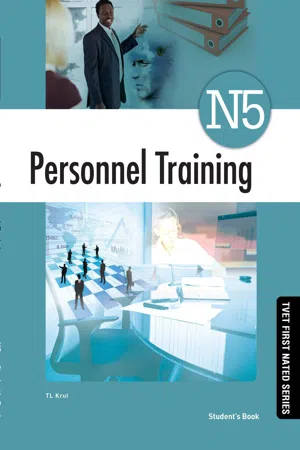Business
Training Methods
Training methods refer to the various techniques and approaches used to impart knowledge and skills to employees. These methods can include on-the-job training, mentoring, workshops, e-learning, simulations, and role-playing. The choice of training method depends on the learning objectives, the nature of the content, and the preferences of the trainees.
Written by Perlego with AI-assistance
Related key terms
1 of 5
5 Key excerpts on "Training Methods"
- Surbhi Jain(Author)
- 2019(Publication Date)
- Society Publishing(Publisher)
A disadvantage is that trainees can become somewhat submissive, counting on the “specialist” to show them what they should be doing and when. Training and Development Methods 147 4.8. SYSTEMATIC APPROACH TO TRAINING 4.8.1. Role of Training To empower the mentor to first appreciate his/her part, it would be useful if training as an idea is quickly probed into. It is perceived that the correct blend of information, aptitudes, and demeanors/practices, encourages an employee to complete responsibilities effectively. Companies attempt to accomplish this by: • Proper choice of the workforce, i.e., selecting the right individual for the correct activity. • Human assets advancement – through training involvement – helping them to learn so as to connect the execution hole, assuming any, and make them more capable. The segment of improvement may likewise be added to this procedure. With the specific end goal to accomplish general objectives of execution change, training must prompt the improvement of expert learning and abilities both at individual and aggregate levels. It ought to be likewise to react appropriately to rising difficulties. Training ought to achieve appropriate changes in dispositions and should also take a stand on the right kind of blend between the change of person’s skills and advancement of hierarchical objectives. 4.8.2. Model of a Systematic Approach to Training To implement training in a precise way, it needs to cover interrelated stages and procedures as graphically delineated in Figure 4.6: Figure 4.6: Systematic Approach Training Model, Source: United Nations Of-fice on Drugs and Crime (UNODC). HR Solutions for Excellence in Training & Development 148 • Organization’s aim. Considerate towards the organization’s objectives and demands and how these objectives are met by the scope of occupation that exists in the organization. • Examining training needs. Discovering what individuals need to realize.- eBook - PDF
Personnel Training N5 SB
TVET FIRST
- TL Krul(Author)
- 2015(Publication Date)
- Macmillan(Publisher)
This means that there is very little opportunity for practical application. Within the ‘off-from-the-job’ method, a number of techniques may be used, including: Videos: the personnel trainer may introduce new concepts or ideas using videos. This technique is often successful because vision and hearing are engaged, and students are able to remember more easily what they have seen and heard. There are endless supplies of free material for trainers online, including websites like www.youtube.com. Lectures: here students sit as a group and listen to presentations offered by a lecturer. The message sent is uniform, and the setting is often very formal. This technique allows for very little individual attention; for lecturers to be successful they should continually offer class activities to ensure all students understand the concepts. Conference: in the business environment, managers and employees often meet to discuss certain problems or opportunities within the organisation. It is important to ensure that everyone involved has a solid understanding of the situation, and that every manager and staff member is aware of his or her role in addressing the situation. A conference is a meeting between managers and employees Formal training and development methods Training and development may take place in a variety of ways. Let us look at the most popular of these: 36 Example 2.2 is “The Business Strategy Game”. Here, an international business environment is simulated, and students compete to perform best in that environment. Top performing students from all over the world may compete against each other. Case studies: students are given an example of a real or fictional organisation facing a particular situation. The students must then analyse that problem or opportunity, and give suggestions on how to deal with it. - eBook - PDF
- Greg L. Stewart, Kenneth G. Brown(Authors)
- 2014(Publication Date)
- Wiley(Publisher)
Training A planned effort to help employees learn job-related knowledge, skills, and attitudes. Knowledge Memory of facts and principles. Skill Proficiency at performing a particular act. Attitude An evaluative reaction to particular categories of people, issues, objects, or events. Learning A change in knowledge, skill, or attitude that results from experience. After reading this chapter you should be able to: Explain how employee training practices can be aligned with an organization’s competitive strategy. Describe how partnering and using a systematic process for developing training helps an organization benefit from training. Discuss the different ways organizations determine their training needs. Describe various Training Methods and explain how to make each more effective. Explain why the purpose of a training evaluation should be used to guide the evaluation process. LEARNING OBJECTIVE 1 LEARNING OBJECTIVE 2 LEARNING OBJECTIVE 3 LEARNING OBJECTIVE 4 LEARNING OBJECTIVE 5 L E A R N I N G O B J E C T I V E S How Can Strategic Employee Training Improve an Organization? How Can Strategic Employee Training Improve an Organization? 337 Most organizations, regardless of size and industry, offer at least some formal training to help employees learn. 2 In a manufacturing setting, for instance, new employees can receive training on how to operate their equip- ment safely and effectively. Employees can learn in other, less formal ways, such as by watching others, asking for help, experimenting, or studying on their own. 3 These informal methods can be effective and inexpensive, so some firms rely heavily on informal learning. Small firms, in particular, often expect their employees to learn mostly through informal means. 4 While informal learning methods can work, they are not always appropri- ate. - eBook - PDF
Industrial/Organizational Psychology
An Applied Approach
- Michael Aamodt(Author)
- 2015(Publication Date)
- Cengage Learning EMEA(Publisher)
Training Methods take many forms. Classroom learning techniques include semi-nars, audiovisual aids, programmed instruction, case studies, and critical incidents. Sample job performance techniques include simulation, role-play, behavior model-ing, and job rotation. Informal training techniques include apprentice training, coaching, and performance appraisal. Such psychological principles as modeling, distributed practice, and transfer of training must be considered when conducting a training program. It is important to evaluate training success by measuring trainee attitudes, knowl-edge, ability to apply newly learned material, and improved performance. Questions for Review 1. In what type of situations is training most useful? Least useful? 2. What motivates employees to learn during training sessions? 3. What would be the best training technique for teaching computer skills? What would be the best technique for customer service skills? 4. Do all new employees model the behavior of more experienced employees? Why or why not? 5. Why would measures of employees’ attitudes about a training program and mea-sures of actual learning be different? Media Resources and Learning Tools Want more practice applying industrial/organizational psychology? Check out the I/O Applications Workbook . This workbook (keyed to your textbook) offers engag-ing, high-interest activities to help you reinforce the important concepts presented in the text. 320 CHAPTER 8 Copyright 2016 Cengage Learning. All Rights Reserved. May not be copied, scanned, or duplicated, in whole or in part. Due to electronic rights, some third party content may be suppressed from the eBook and/or eChapter(s). Editorial review has deemed that any suppressed content does not materially affect the overall learning experience. Cengage Learning reserves the right to remove additional content at any time if subsequent rights restrictions require it. - eBook - PDF
- Max Messmer, Anne M. Bogardus, Connie Isbell(Authors)
- 2015(Publication Date)
- Wiley(Publisher)
6 TRAINING EMPLOYEES Enhancing Productivity and Corporate Viability Starting Point Go to www.wiley.com/college/messmer to assess your knowledge of the basics of employee training. Determine where you need to concentrate your effort. What You’ll Learn in This Chapter ▲ Factors that influence the effectiveness of employee training programs ▲ The basic steps of an employee training process ▲ Familiar approaches to employee training ▲ Common employee training topics ▲ Ways of measuring the effectiveness of training programs After Studying This Chapter, You Will Be Able To ▲ Evaluate the appropriateness of training for a particular corporate situation ▲ Assess the training needs of a situation using a needs assessment worksheet ▲ Choose the most effective training approach for a company’s needs ▲ Defend the use of a communications training program for mid-level managers ▲ Test the effectiveness of a training program using any of four accepted practices 6.1 DETERMINING WHAT TRAINING CAN DO FOR YOU 125 INTRODUCTION Broadly speaking, employee training refers to everything your organization does to upgrade the skills and improve the job performance of your employees, both in the short term and long term. Training encompasses a wide range of learning-based tools, ranging from a live seminar to a DVD instructional session used at their desks. In the HR role for your company, it’s your responsibility to not only determine the best training approaches but also to organize and run these pro- grams in a cost-effective way that’s in line with your organization’s overall culture. 6.1 Determining What Training Can Do For You No matter what the nature of your business, you won’t find it easy to stay on top without a commitment to helping your people stay ahead of emerging trends and changing needs. Increasing the knowledge of your workforce not only enhances your ability as a company to compete but also makes for more satisfied employ- ees.
Index pages curate the most relevant extracts from our library of academic textbooks. They’ve been created using an in-house natural language model (NLM), each adding context and meaning to key research topics.




